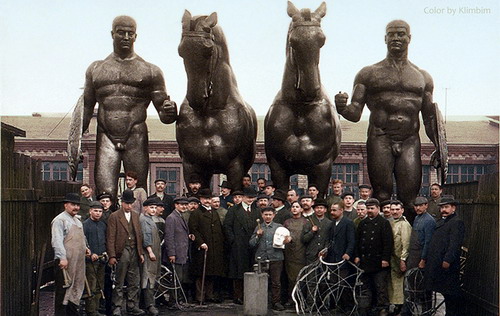When you look at this photograph of Franz Horst Link it comes to mind that this is a classic example of the German totalitarian art of the 1930s. Surprising but this picture is made in the city center of St. Petersburg. The sculpture was on the roof of the German embassy on St. Isaac’s Square.
At the end of 1909 it was announced that the mansion of the XIX century, built by the project Stasov in the Empire style, will be rebuilt. The Reichstag has allocated 1.7 million rubles, and the German Foreign Ministry has instructed the German architect Peter Behrens. The building was supposed to express the national style and stand out from the buildings of St. Petersburg.
When on January 27, 1913, the birthday of Emperor Wilhelm II, the falsework was removed, Petersburg was shocked.
Embassy proved a huge building in the neoclassical style, cold and massive. It reminded the architects factory or warehouse and was criticized for «stockade poles», lack of taste, and the inappropriateness of such a giant in the city center.
But the embassy has filed another secret which impressed even more. The building was only the pedestal to the sculptural group of the Dioscuri. It was a pair of muscular, heavy warriors with stern faces of the Teutons. The figures were designed by the E. Enke in Berlin, in one of the most prestigious bronze foundries SA Loewy.
Franz Linkhorst specializing in photographing sculptures, took this picture on the roof of the German Embassy after the installation of sculptures. Head of the foundry company SA Loewy, who came specially to direct the work, stands at the center of the composition of the workers of the enterprise.
However, apart from this picture, there is nothing left. In 1914, one year after the controversial installation of statues, the First World War begun. Patriotic crowd went to the German embassy, to overthrow «ugly statues of naked Germans», expressing the opinion of many, the militaristic nature of the enemy. The crowd roared whe


